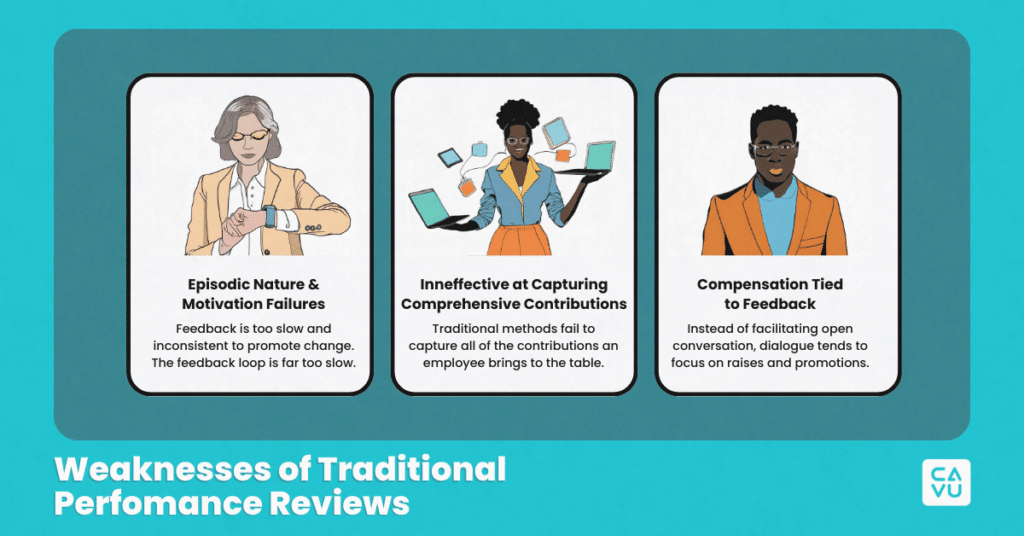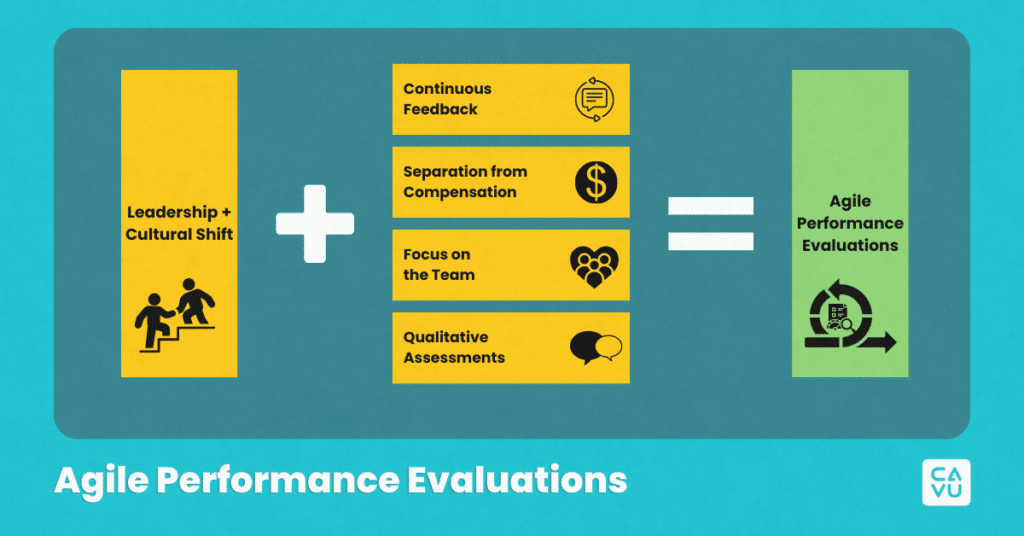How often have you wished that performance evaluations could be more than just an annual process dreaded by both employees and managers? Let alone by HR professionals who want it to be so much more than a process? What if performance evaluations could be a continuous celebration of growth, alignment, teamwork, and Agility?
While this topic may seem like it’s been discussed and debated for over a decade (and in my experience it has been) you may ask what makes it to the top of the list for conversation in 2024? It is simply that very few organizations have been able to make the shift to a different way of evaluating performance as more and more have shifted to Agile ways of working and embracing Agile principles. Often the transformation lags behind when it comes to HR practices – for many reasons
In the traditional business landscape, performance evaluations have often been a source of anxiety and uncertainty, focusing more on ticking boxes and less on real development and contribution. Yet, as organizations increasingly adopt Agile ways of working and modern mindsets about people and work , the call for a fundamental transformation in how to assess and understand performance has never been louder.
Agile ways of working and being invite us to rethink yes, the frequency of formal evaluations, and more importantly the very essence of performance evaluations and their place in the modern workplace. It encourages us to shift our focus from solely outcomes to the processes, behaviors, and team dynamics that lead to those outcomes. In an Agile world, performance evaluations are transformed into a continuous, collaborative journey of feedback and growth, opening up a myriad of opportunities for HR professionals to innovate and inspire – creating a unique workplace environment that makes it easy for people to say “yes” to sharing their time and talents there.
In the midst of talent wars and the ever-spinning merry-go-round of engagement and retention, the solution might be found in the culture we build. A workplace where performance evaluations grow beyond their traditional role to become the heartbeat of an ecosystem built on actual growth, learning, and genuine development. This approach does not just offer individuals a “clock-in, clock-out” job but a journey of continuous learning and meaningful contribution.
Performance evaluations, when reimagined to celebrate growth, alignment, teamwork, and Agility, could become the bedrock of an organizational culture that not only draws in top talent but also keeps them engaged. This shifts the narrative from combating engagement and retention issues to making your organization suddenly the place where people want to stay for the long term, grow their “roots”, and flourish. Where individuals are not just present but are invested in their own personal growth and the collective success of the organization.
The Shortcomings of Traditional Performance Evaluations

As someone who has been steeped in the evolution of HR through the lens of Agile and Scrum methodologies, I’ve observed firsthand the limitations of traditional performance evaluations. These systems, while established with the best intentions, often miss the mark in fostering real growth and development among employees. They are often created prior to shifts to new ways of working that value teaming and incremental assessment of performance over monolithic evaluations of performance against fixed criteria set on an annual basis.
Episodic Nature and Motivation Failures:
Traditional performance evaluations are typically annual events that, despite their regularity, disrupt the flow of ongoing development rather than support it. This episodic approach not only stalls continuous improvement but also fails to effectively motivate. It’s akin to receiving feedback on a project months after its completion; the opportunity for immediate learning and adjustment has long passed. While many organizations tout continuous feedback through 1:1 conversations between employees and managers, the consistency, and at times quality, of such interactions does not close the gap needed to create a true culture of performance management and professional development.
Ineffectiveness in Capturing Comprehensive Contributions:
The traditional model often overlooks the multifaceted contributions of employees. It’s not just about the tasks completed or the goals met. It’s about the innovative ideas brought to team meetings, the extra hours mentoring new colleagues, and the adaptability shown in the face of changing project scopes. These contributions, though crucial to a team’s success, often go unrecognized in conventional evaluation frameworks. Perhaps worse, some evaluations try so hard to cover every single aspect of performance that they end up more like a painstakingly detailed thesis on an employee’s performance—overwhelming rather than helpful, and focusing more on justification for employment rather than paving the way for meaningful development and positive contribution.
Compensation and Performance Reviews:
Linking performance reviews directly to compensation decisions can skew the focus of evaluations. I get it, businesses have always found it challenging to defend compensation decisions, often hampered by limited budgets (hello 2% raises!), and performance ratings are a fast way to make seemingly objective decisions about who gets what. That being said, instead of facilitating open, honest conversations about growth and development, the dialogue tends to be centered around justifying a raise or promotion, or lack thereof – completely wrecking any hopes of increasing engagement and retention of great people. This conflation of development with financial reward can muddy the waters, making it challenging to focus on the genuine contributions and areas of professional growth of the employee.
As organizations embrace Agile, it’s clear that individual-centric evaluations and compensation models don’t mesh well with team-based work. This shift necessitates rethinking how financial incentives align with Agile’s collaborative approach—maybe we’ll look at this in another blog post
Bottom-line: A Change is Necessary:
The traditional approach to performance evaluations is at odds with the dynamic, collaborative nature of Agile work environments. They unfortunately fail to capture the essence of what makes Agile teams and organizations successful: continuous improvement, collective achievement, and adaptability. As we explore the Agile approach to performance evaluations, it’s crucial to envision a system that solves these shortcomings and aligns with the principles of teamwork, flexibility, and ongoing feedback that are central to Agile methodologies. Creating a new way of working and operating that attracts, develops, and engages people while delivering reliable results to those you are in service to.
The Agile Approach to Performance Evaluations
Agile philosophy challenges us to rethink the traditional, and turn the spotlight onto a more dynamic, collaborative, and iterative approach to performance evaluations and in kind performance management overall. It’s about creating a workplace environment where feedback and coaching are not an annual occurrence – rather they are a part of our everyday work life experience – the norm for all.
This approach encourages a shift from the traditional performance evaluation’s episodic nature to a more fluid, ongoing process. It invites us to inspect and adapt regularly, offering feedback that is immediate (or at least reliably frequent) and relevant. This change embodies the values of collaboration, transparency, and adaptability. By integrating these values into performance evaluations, we create a feedback loop that is more effective and aligned with the way Agile teams and organizations work.
Agile evaluations focus on both individual and team contributions. This dual focus recognizes the importance of individual effort while also emphasizing the collective achievement of the team. In an Agile environment, success is not just about what one can do alone, it is also how one contributes to the team’s goals and the organization’s overall objectives. While many might fear team based performance measures over individual ones, an Agile approach lends to valuing both as a way to get to delivering on what matters most to the people that the organization is in service of. Too often the individual focus leads many to lose sight of the big picture – the customers, users, clients, patients, etc. we are there to serve.
For HR professionals and organizational leaders contemplating the Agile shift, or those who are on the road already, this presents a tremendous opportunity to revolutionize performance management. Agile evaluations offer a way to truly understand and enhance both individual and team performance, driving growth and development in a way that traditional methods cannot match. This approach is about assessing outcomes and about nurturing the processes, behaviors, and dynamics that lead to those outcomes. Because of this, things like development planning and investment in learning become timely and informed investment decisions – not simply a feeling of what we think we can get better at.
The Key Features of Agile Performance Evaluations

While there are no set rules for what an Agile performance evaluation must be, there are a few elements that are pretty important to focus on if you want the benefits of an improved process and experience from what you have today.
Leadership and Cultural Shift:
First and perhaps most important, the successful implementation of Agile performance evaluations requires a significant shift in leadership style and organizational culture. Leaders must embrace a coaching mindset, where their primary role is to support and develop their team members – rather than judges, guiding their teams through the transition and fostering an environment where feedback is seen as a tool for growth rather than criticism. Similarly, organizations must cultivate a culture of continuous learning and improvement, where feedback is seen as a valuable tool for development rather than a judgment of worth.
Moreover, leaders must champion the cultural shift necessary for Agile evaluations to take root. This means advocating for values such as transparency, collaboration, and mutual respect, and creating spaces where these values can flourish. It’s about building a culture where feedback is not only accepted but actively sought as a pathway to personal and team development.
Underestimating the importance of this shift is like leaving the house without an umbrella when the weather is calling for 100% rain. And as we discuss below, the shift can happen as you are evolving performance evaluation practices – in fact I recommend it for a change that sustains over the long-term.
Continuous Feedback:
The cornerstone of Agile performance evaluations is the emphasis on continuous feedback. This ongoing process is pivotal for fostering an environment of growth and adaptation. By engaging in regular check-ins, we ensure that feedback is timely, relevant, and, most importantly, actionable. This approach allows for immediate adjustments, reinforcing positive behaviors and addressing any areas of concern before they become ingrained patterns.
Much like the Scrum framework, building in a regular time to reflect, inspect, and adapt makes for increased trust and collaboration – allowing people managers to become people leaders focused primarily on coaching and development instead of work allocation and productivity tracking.
Separation from Compensation:
One transformative aspect of Agile evaluations is the decoupling of performance discussions from compensation decisions. This separation fosters a more honest and open dialogue about performance, free from the anxiety that often accompanies compensation discussions. By focusing on development and improvement in these evaluations, we create a space where employees are motivated to grow for the sake of learning, not just a financial reward.
This is not to say that performance is not a part of compensation decisions – it is and has to be considered as part of the bigger picture of incentives, motivation, and rewards. And it is certainly not the only factor – a topic we will cover in depth soon.
Focus on Team Dynamics and Performance:
Agile evaluations also mark a significant shift towards recognizing the importance of team dynamics and performance alongside individual achievements. In Agile environments, the success and health of the team is as critical as the success of any single individual. This focus on team performance encourages a collaborative culture, where team members are motivated to support each other’s growth and success.
Balancing the recognition of individual contributions within a team context can be complex. Agile doesn’t diminish the value of individual efforts; instead, it seeks to harmonize individual achievements with team success. This balance is crucial for maintaining motivation and ensuring that all team members feel valued and recognized for their contributions
Qualitative Assessments:
Moving away from numeric ratings towards more qualitative, conversational feedback is another hallmark of Agile performance evaluations. This approach encourages a more nuanced understanding of performance, focusing on the quality of work, the effectiveness of collaboration, and the demonstration of Agile values. It’s about fostering a dialogue that helps individuals and teams understand their strengths and areas for improvement in a constructive and supportive manner.
Think in terms of categories like, “Exemplar”, “Reliable”, “High Impact”, “Consistent”, “Growth Opportunity”, “Unhelpful”, “Misdirected”, “No Opportunity to Demonstrate Yet”, “Not Willing”. While these words can appear subjective, with refinement and shared understanding of meaning they can lead to conversations that help people understand how they affect the workplace and adjust or amplify performance and behaviors accordingly in near real-time. The shared language helps everyone, not only people managers, understand what is helpful and expected to be a helpful person in the organization – removing ambiguity and sharing ownership for the health of the culture.
Removing numeric scoring can intimidate many managers concerned with being fair and consistent in their evaluations – especially true in organizations who fear lawsuits from wrongful terminations. I understand – and I also challenge that with practice and calibration across teams and leaders this can be a game-changing approach to creating a truly high performance organization where uncomfortable employee conversations can start to become a mere memory in the modern workplace.
Creating and Implementing Agile Performance Evaluations

Starting Where You Are:
Transitioning to Agile evaluations introduces its own set of challenges, from initial resistance to change to the delicate balance between individual and team performance metrics. Resistance often stems from a fear of the unknown or a perceived increase in workload.
Making wholesale change is never a good practice – especially when it comes to the very personal nature of evaluating people and their contributions. Perhaps the best first step is to assess what is working in your current approach – being objective about the value a process step or tools (and there are a lot of them in the performance evaluation space – let’s leave them aside for now) brings to the organization. Then be honest with what no longer serves you well as you evolve your workplace practices. Not blaming or criticizing how you got to now – rather using reality as the filter through which you assess and make choices about what changes to prioritize.
The essence of Agile—its iterative nature and focus on continuous improvement—serves as a counterbalance to fear or concerns about change. Embracing an Agile mindset means recognizing that change is a process, not an event, and requires patience, persistence, involvement at all levels and a willingness to adapt based on experience and feedback.
Iterative and Collaborative Approach:
Adopting an experimental, iterative approach to refining evaluation methods is vital. Start small, with manageable changes that allow for quick feedback and adjustments.
For example, introducing more frequent feedback sessions or incorporating peer reviews can be initial steps that gradually build towards a more comprehensive Agile evaluation system. This approach reduces the risk associated with big changes and helps to build buy-in and understanding across the organization.
This is a great place to use Agile methods too. Creating a backlog of things that you want to improve in the process, defining ratings, in skill development around coaching and feedback, re-implementing digital tools to support the process, and so on. Recruiting a cross-functional team of influencers to build the new way of doing performance evaluations is a great place to use Scrum to deliver incremental changes as well as to work with the entire organization as customers to provide feedback on the work. It’s a perfect opportunity to work on the culture shift as well as develop change champions by including employees and people leaders on the team. To learn more, sign up here for information about our Scrum in HR course coming up in the next few months.
Conclusion

The journey towards implementing Agile performance evaluations represents a significant shift from traditional, compliance-driven processes to a more dynamic, collaborative, and growth-oriented approach.
This transformation aligns with the Agile values of continuous improvement, adaptability, and teamwork, offering a fresh perspective on how performance can be assessed and enhanced within organizations.
Through the adoption of continuous feedback, the decoupling of evaluations from compensation, a focus on qualitative assessments, and the emphasis on both individual and team contributions, Agile performance evaluations promise a more holistic, accurate, and motivational approach to understanding and fostering employee performance.
The success of this transition requires more than simply changing forms and frequencies; it demands a cultural shift towards valuing learning and development as ongoing processes. Leadership plays a crucial role in this transformation, acting as coaches and facilitators who guide their teams through the change, championing the principles of Agile, and modeling the behaviors they wish to see.
For HR professionals and organizational leaders contemplating this shift, the journey towards Agile performance evaluations is not only a procedural change, it is an opportunity to deeply impact the employee experience, the organizational culture, and how your customers experience working with your company. It represents a move towards creating environments where employees feel valued, motivated, and aligned to what matters most – where they can give their best to the work and feel good about sharing their time and talents with your organization and its mission. Treating people with this level of respect does more for the bottom-line, your reputation, and your results than you can imagine.








